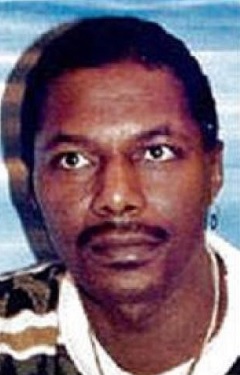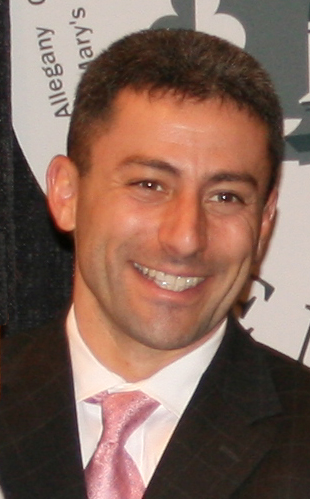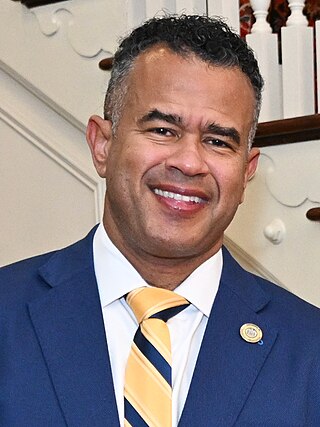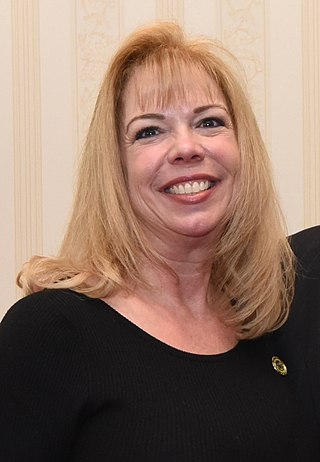
Homicide is an act in which a person causes the death of another person.

Capital punishment was abolished via the legislative process on May 2, 2013, in the U.S. state of Maryland.
Capital punishment is a legal penalty in the U.S. state of Nebraska. In 2015, the state legislature voted to repeal the death penalty, overriding governor Pete Ricketts' veto. However, a petition drive secured enough signatures to suspend the repeal until a public vote. In the November 2016 general election, voters rejected the repeal measure, preserving capital punishment in the state. Nebraska currently has 12 inmates on death row.

"Maryland, My Maryland" was the state song of the U.S. state of Maryland from 1939 until 2021. The song is set to the melody of "Lauriger Horatius" — the same tune "O Tannenbaum" was taken from. The lyrics are from a nine-stanza poem written by James Ryder Randall (1839–1908) in 1861. The state's general assembly adopted "Maryland, My Maryland" as the state song on April 29, 1939.

Wesley Eugene Baker was an American convicted murderer executed by the U.S. state of Maryland. He was convicted for the June 6, 1991, murder of Jane Frances Tyson, a mother and grandmother, in front of two of her grandchildren in Catonsville. He was the last person to be executed in Maryland.

The Baltimore Police Department (BPD) is the municipal police department of the city of Baltimore, Maryland. Dating back to 1784, the BPD, consisting of 2,935 employees in 2020, is organized into nine districts covering 80.9 square miles (210 km2) of land and 11.1 square miles (29 km2) of waterways. The department is sometimes referred to as the Baltimore City Police Department to distinguish it from the Baltimore County Police Department.

Samuel Isadore Rosenberg is an American politician who has served as a member of the Maryland House of Delegates representing northwest Baltimore since 1983. He is currently the longest serving member of the Maryland General Assembly.
Murder of pregnant women is a type of homicide, often resulting from domestic violence. Domestic violence—or intimate partner violence (IPV)—is suffered by many, and when analyzing cases in which victims came forward, men are more likely than women to commit acts of severe domestic battery, and women are more likely to suffer serious injury as a result. Many of these women fear harm not just to themselves but also to their unborn children. Recently, more focus has been placed on pregnancy-associated deaths due to violence. IPV may begin when the victim becomes pregnant. Research has shown that abuse while pregnant is a red flag for pregnancy-associated homicide.

Aisha Nazapa Braveboy is an American politician and attorney who has served as the state's attorney of Prince George's County, Maryland since 2018. She was previously a member of the Maryland House of Delegates, representing the 25th district from 2007 to 2015.

Nancy J. King is an American politician who is a member of the Maryland Senate from the 39th district since 2007. A member of the Democratic Party, she has served as the majority leader of the Maryland Senate since 2020. King previously represented the district in the Maryland House of Delegates from 2003 to 2007.

Jeffrey D. Waldstreicher is an American politician from Maryland and a member of the Democratic Party. He is currently a member of the Maryland Senate, representing District 18 in Montgomery County after serving two terms in the Maryland House of Delegates.

Robert A. "Bobby" Zirkin is an American politician from Maryland and a member of the Democratic Party. He represented Maryland's District 11 in Baltimore County in the Maryland House of Delegates from 1999 to 2007 and in the Maryland State Senate from 2007 to 2020.
In 2015 there were 166,510 crimes reported in the U.S. state of Maryland, including 493 murders.
In the United States, the law for murder varies by jurisdiction. In many US jurisdictions there is a hierarchy of acts, known collectively as homicide, of which first-degree murder and felony murder are the most serious, followed by second-degree murder and, in a few states, third-degree murder, which in other states is divided into voluntary manslaughter, and involuntary manslaughter such as reckless homicide and negligent homicide, which are the least serious, and ending finally in justifiable homicide, which is not a crime. However, because there are at least 52 relevant jurisdictions, each with its own criminal code, this is a considerable simplification.

C. T. Wilson is an American politician and attorney who has represented District 28 in the Maryland House of Delegates since 2011.
Crime in Oakland, California began to rise during the late 1960s after the King assassination riots, and by the end of the 1970s Oakland's per capita murder rate had risen to twice that of San Francisco or New York City. In 1983, the National Journal referred to Oakland as the "1983 crime capital" of the San Francisco Bay Area. Crime continued to escalate during the 1980s and 1990s, and during the first decade of the 21st century Oakland has consistently been listed as one of the most dangerous large cities in the United States.
The American city of Baltimore, Maryland, is notorious for its crime rate, which ranks well above the national average. Violent crime spiked in 2015 after the death of Freddie Gray on April 19, 2015, which touched off riots and an increase in murders. The city recorded 348 homicides in 2019, a number second only to the number recorded in 1993 when the population was nearly 125,000 higher.
Daniel W. Webster is an American health policy researcher and the distinguished research scholar of the Johns Hopkins Center for Gun Violence Solutions at Johns Hopkins Bloomberg School of Public Health. He is also the deputy director for research at the Johns Hopkins Center for the Prevention of Youth Violence, and the first Bloomberg Professor of American Health at the Johns Hopkins Bloomberg School of Public Health. In 2016, he became the director of the Johns Hopkins-Baltimore Collaborative for Violence Reduction, a joint crime-fighting effort between Johns Hopkins and the Baltimore Police Department.

April R. Rose is an American politician who is a member of the Republican Party who represents the fifth district in the Maryland House of Delegates. She has also served as the Assistant Minority Leader since 2021.
White Marylanders are White Americans living in Maryland. As of 2019, they comprise 57.3% of the state's population. 49.8% of the population is non-Hispanic white, making Maryland a majority minority state. The regions of Western Maryland, Southern Maryland and the Eastern Shore all have majority white populations. Many white Marylanders also live in Central Maryland, including Baltimore, as well as in the suburbs of Washington, D.C. Garrett County (97.5%) and Carroll County (91.9%) are the counties with the highest percentage of white Americans. Garrett and Carroll counties also have the highest percentage of non-Hispanic whites at 96.3% and 88.7%, respectively. Prince George's County (27%), Baltimore (30.4%), and Charles County (42.8%) have the lowest percentages of white people. Prince George's County has the lowest percentage of non-Hispanic whites, at 12.5% of the population. White Marylanders are a minority in Baltimore, Cambridge, Charles County, Jessup, Owings Mills, Prince George's County, Randallstown, and White Oak. Non-Hispanic whites are the plurality in Montgomery County, Columbia, Elkridge, Reisterstown, Salisbury, and Severn.












